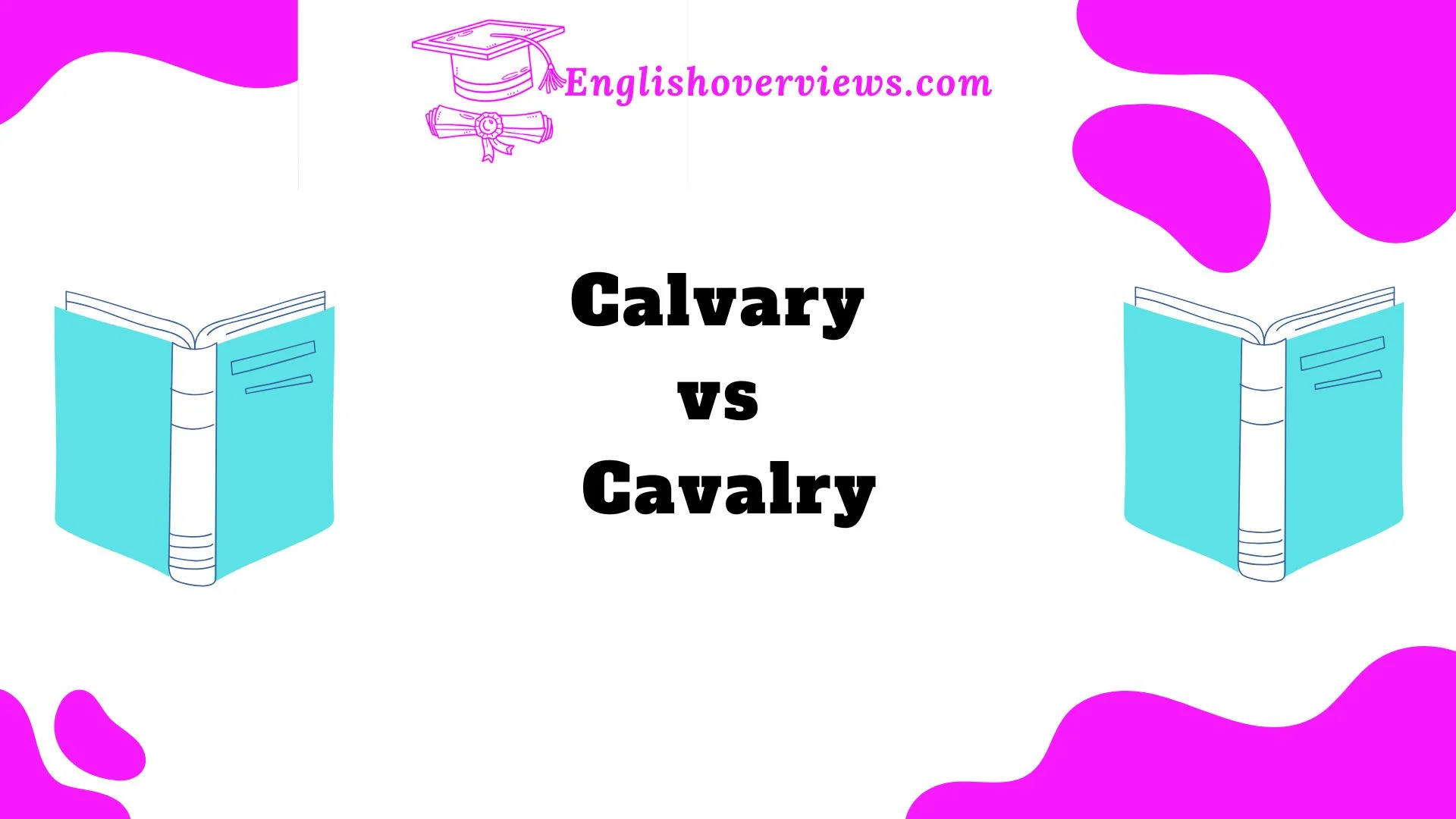Have you ever mixed up the words “Calvary” and “Cavalry”? You’re not alone. These two terms are often confused, not just because they sound similar but also because they carry very different meanings.
Calvary is associated with Christianity and sacrifice, while Cavalry refers to a specific type of military unit. In this blog post, we’ll explore the differences, origins, and significance of both terms.
By the end, you’ll know when to use each word and how to remember the difference. Whether you’re writing a historical essay, delivering a speech, or just curious, this guide will clear up any confusion once and for all.
Understanding the Two Terms: Definitions and Core Differences
When it comes to Calvary and Cavalry, the terms are often mistakenly used interchangeably, but they have distinct meanings and usages.
- Calvary refers to a location tied to Christian tradition, specifically the hill where Jesus was crucified. The term comes from the Latin word calvaria, which means “skull.” In modern contexts, Calvary is often associated with religious events, artwork, and expressions related to sacrifice or suffering.
- Cavalry, on the other hand, refers to mounted soldiers. Historically, these soldiers were typically on horseback and played a critical role in warfare. The word comes from the Italian cavalleria, referring to soldiers who fought from horseback. Over time, Cavalry evolved to include mechanized and armored units in modern military forces.
In essence, while Calvary is all about religious significance, Cavalry is firmly rooted in military history.
Origins of the Terms: Etymology and Historical Context
Let’s dive deeper into the origins of these two words to understand why they’re so different.
The Origins of Calvary
The word Calvary comes from the Latin calvaria, meaning “skull.” This refers to Golgotha, the hill where Jesus Christ was crucified. The term has strong religious connotations, especially in Christianity, where Calvary symbolizes suffering and sacrifice.
- In the New Testament, Calvary is the place of Jesus’ crucifixion, where he endured immense physical and emotional suffering for the salvation of human beings.
- Over time, the word evolved to be used symbolically, representing personal suffering, redemption, and spiritual growth.
The Origins of Cavalry
Cavalry comes from the Italian word cavalleria, which means “mounted soldiers” or “horsemen.” This reflects its military roots dating back to ancient times when soldiers would fight from horseback, gaining advantages in mobility, speed, and striking power.
- In medieval times, cavalry units were pivotal in battles and wars.
- The use of mounted warriors became a cornerstone of military strategy, as they could swiftly maneuver and attack enemies from a higher vantage point.
- Over time, Cavalry evolved with advances in technology. Today, the term refers to various types of mechanized and armored military units.
Key Takeaway:
- Calvary has religious roots, linked to Christ’s sacrifice.
- Cavalry is a military term referring to soldiers on horseback.
The Religious and Historical Significance of Calvary
Calvary holds deep religious significance within Christianity. It represents the crucifixion of Jesus Christ, a pivotal event that serves as the foundation for the Christian faith.
The Crucifixion of Jesus at Calvary
The crucifixion of Jesus on Calvary is central to Christian belief:
- Christ’s sacrifice on the cross is seen as a redemptive act for the sins of humanity.
- The word Calvary is used in Christian liturgies, hymns, and prayers to refer to this sacrifice.
In many Christian cultures, Calvary is a site of pilgrimage. Christian pilgrims visit Jerusalem, where Golgotha, or Calvary, is located, to pay their respects to the sacred ground where Jesus gave his life.
Symbolism in Art and Culture
- Calvary is depicted in Christian art as a hill, often shown with a cross at its summit.
- The symbol of the cross has since become the most recognizable symbol of Christianity worldwide.
- In churches and religious observances, the term Calvary is often invoked to remind believers of the suffering and redemption that Christ’s death symbolizes.
The Role of Cavalry in Warfare: A Historical Overview
Unlike Calvary, which is deeply religious, Cavalry is all about military history. The concept of Cavalry dates back to ancient civilizations, where soldiers on horseback played a vital role in battle.
Early Use of Cavalry
Cavalry played an instrumental role in many early battles:
- The Egyptians, Persians, and Mongols were known for their use of mounted soldiers.
- The Mongol empire is particularly famous for its use of Cavalry in sweeping conquests, utilizing speed and maneuverability.
Cavalry in Medieval Times
During the Middle Ages, cavalry became essential in European warfare. Knights were among the most well-known cavalrymen, riding into battle with armor and weapons designed for horseback fighting.
- Knights were heavily armed, with lances and swords, and they played a key role in battles such as the Battle of Agincourt.
- Cavalry charges were often a decisive factor in the outcome of medieval wars.
Cavalry in Modern Times
Though Cavalry has evolved into modern armored units, the legacy of mounted soldiers continues:
- Modern Cavalry includes units like the U.S. Army’s armored cavalry, which uses tanks and armored vehicles for reconnaissance and combat.
Pronunciation and Common Pitfalls: Why It Matters
Pronouncing Calvary and Cavalry correctly can be tricky, especially because they sound similar but are spelled differently.
How to Pronounce Calvary
- Calvary is pronounced as “KAL-vuh-ree”, with the emphasis on the first syllable. The “a” is pronounced like the “a” in “cat.”
- It’s important to avoid pronouncing it as “Cavalry”, as it changes the meaning entirely.
How to Pronounce Cavalry
- Cavalry is pronounced as “KAV-uhl-ree”, with the emphasis on the first syllable. The “a” sounds like the “a” in “cat,” but it’s followed by the “v” sound.
- Mispronouncing Cavalry as “Calvary” can lead to confusion, especially in military contexts.
Common Pronunciation Mistakes
- “Calvary” and “Cavalry” often get mixed up in conversation, particularly when speaking quickly.
- It’s a simple mistake but can alter the intended meaning of a sentence.
How to Easily Remember the Difference
Remembering the difference between Calvary and Cavalry can be tricky, but there are a few memory tricks you can use to keep them straight.
Tips to Remember
- Calvary has an “A” in it, which you can associate with “A” for “altar” or “assistance”—both associated with religious concepts.
- Cavalry contains “V,” which is for “vehicle” or “vanguard”, suggesting movement and action, much like mounted soldiers in battle.
Examples in Context: Using Calvary and Cavalry in Sentences
To make the distinction clearer, here are examples of how Calvary and Cavalry should be used in sentences:
- Calvary: “The church’s altar was adorned with a painting of Calvary, depicting the crucifixion.”
- Cavalry: “The Cavalry charged the enemy’s lines with incredible speed, breaking through their defenses.”
Key Difference
- Calvary is associated with religious suffering and sacrifice.
- Cavalry is related to military strategy and mounted troops.
Conclusion: Why Knowing the Difference Matters
By now, you should have a clearer understanding of the difference between Calvary and Cavalry. These words, while often confused, have distinct meanings tied to religion and military history, respectively. Whether you’re writing a religious paper, discussing historical battles, or simply trying to improve your vocabulary, knowing when to use each term will help you communicate more effectively.
FAQs
What is the difference between Calvary and Cavalry?
- Calvary refers to a religious term, specifically the hill where Jesus was crucified. Cavalry refers to soldiers who fought on horseback, a term used in military contexts.
How do you pronounce Calvary and Cavalry?
- Calvary is pronounced “KAL-vuh-ree” and Cavalry is pronounced “KAV-uhl-ree.”
Why is it important to know the difference between Calvary and Cavalry?
- Knowing the difference ensures clear communication, especially when discussing religious topics or military history. It also helps prevent mispronunciations that can cause confusion.
Can Cavalry be used today in the military?
- Yes, modern Cavalry units have evolved into armored and mechanized units using tanks and reconnaissance vehicles.

English Overviews is a resourceful website dedicated to providing valuable content related to grammar and vocabulary. Muhammad Haroon has made notable contributions, sharing insights on various subjects, including WordPress themes and plugins. The primary goal of the site is to help users improve their English language skills effectively.











